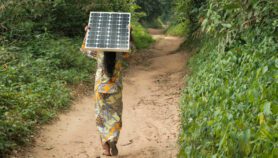By: Radhika Perrot
Send to a friend
The details you provide on this page will not be used to send unsolicited email, and will not be sold to a 3rd party. See privacy policy.
South Africa must get better at acquiring green knowledge and technology transfer — or be left out of global markets, says Radhika Perrot.
Technology transfer has a fair mention in the Kyoto Protocol, with the Clean Development Mechanism (CDM) the main market instrument designed to transfer technology from Northern to Southern countries.
CDM is intended to help developing countries, like South Africa, leapfrog to low-carbon technologies and build their industrial capacities for green energy. The broader goal is to mitigate global carbon emissions. But so far there is little evidence that CDM has taken effect — and it definitely has not in South Africa.
Pre-CDM still works for some
Emerging countries like China and India still rely on conventional technology transfer to develop their wind and solar PV manufacturing industries. They look to efficiency-seeking foreign direct investment (FDI), joint-ventures and policies that require local content in investments.
But South Africa has never attracted this kind of manufacturing FDI, with the exception of the automobile and automobile components industry. The problem is that investors typically seek more than just cheap labour and access to natural resources. They also want competitively-priced materials and other inputs.
Despite being well-endowed in solar and wind energy resources, South Africa has not developed a robust renewable energy industry, either through its CDM activities, carbon financing, the government’s Long Term Mitigation Strategy (LTMS) which scientifically evaluated future energy scenarios on which South Africa’s renewable energy policies are based, nor through its industrial policies.
The country is heavily dependent on coal, which is still very cheap. Though the LTMS and South Africa’s 2004 White Paper on the Promotion of Renewable Energy and Clean Energy Development have outlined strategies to switch to renewables, the country’s renewable energy policies have been ineffective and fraught with administrative barriers.
There are too many agencies involved; the time to process a licence is too long; financiers are hard to convince; environmental impact assessment procedures can be cumbersome; and there are ambiguities on power purchase agreements.
Local manufacturing underdeveloped
One of the objectives outlined in the 2004 White Paper is "appropriate research, development and local manufacturing to strengthen renewable energy technologies and optimize their implementation". But there is no official plan of how local manufacturing will be developed.
South Africa does have an industrial policy requiring foreign firms to partner with a local BEE (Black Economic Empowerment) company — part of an affirmative action post-apartheid effort to empower the historically disadvantaged in society. But unfortunately few BEE firms are entrepreneurial technology start-ups, or firms with manufacturing skills and capabilities.
Yet local firms’ capacity to absorb knowledge is crucial in knowledge-sharing partnerships with foreign firms. Companies should be able to quickly acquire knowledge, technology and skills that can then spill over to the rest of the economy. Encouragement for this has been grossly neglected in South Africa.
By contrast, India’s unique policy of technology transfer through interactive learning with international, and especially Danish, firms has contributed to the country’s success in developing its wind energy industry. A dozen major international wind energy companies manufacture wind turbines in India through joint ventures. Such methods of technology transfer have encouraged a strong domestic manufacturing sector, and some foreign companies even source more than 80 per cent.
When the Danish wind turbine manufacturer Vestas entered India in 1989, the Indian pre-reform industrial policy required an equity partnership with an Indian firm — RRB Energy. RRB Energy started as a manufacturing facility to develop wind-driven electricity generators, one of the main components in wind turbine technology. Through its partnership with Vestas the company was able to acquire advanced wind turbine technologies and production capabilities. Today RRB is one of the world’s leading manufacturers of wind turbines.
China is ahead
China has a local content requirement for foreign firms setting up a renewable energy manufacturing plant in China. They must meet the requirement of sourcing 70 per cent of the manufacturing content and components from Chinese manufacturers and suppliers. Through this policy, Chinese firms have already built up their technological know-how in renewable energy and are now competing internationally with large established wind turbine manufacturers, including Vestas, Siemens and GE Energy.
Chinese solar photovoltaic firm, Suntech Power Holdings Co Ltd is not physically present in South Africa. But early this year it signed a deal with an unnamed South African partner to develop solar plants in South Africa, with a total capacity of up to 100 megawatts. However, details of the non-binding agreement are undisclosed. Without such critical information, especially regarding the terms of the technology transfer agreement between Suntech and the South African firm, it is difficult to say with certainty if South Africa has finally embarked upon technology transfer in renewable energy development.
While the development of solar plants in South Africa is a clear indication of building capabilities in renewable energy and a necessary condition for technology transfer, but it is not sufficient as technology transfer can only be determined ex-ante.
Unless South Africa quickly develops strong technology transfer policies defining such agreements, the ‘bandwagon’ of manufacturers in the global market will be firmly European, American and Chinese firms before technology spillovers and local skills begin to boost the South African economy.
By then, renewable energy technologies will be far too advanced for South African entrants to fiercely compete in established markets.
As things stand, jobs will be generated when foreign firms engage in local manufacturing. But local science and technology policies must urgently be designed to include deliberate technology transfer components. If they do, the positive effects will eventually trickle down to local enterprises, and create an industry based on local manufacturing capabilities.
Radhika Perrot is a PhD candidate at UNU-MERIT, Netherlands, and Innovation and Sustainable Energy Researcher at the WITS Business School, Johannesburg, South Africa.













